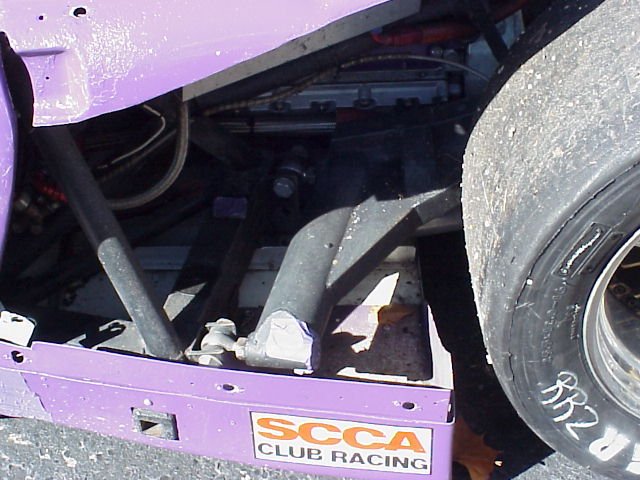|
|

|
Porsche, and the Porsche crest are registered trademarks of Dr. Ing. h.c. F. Porsche AG.
This site is not affiliated with Porsche in any way. Its only purpose is to provide an online forum for car enthusiasts. All other trademarks are property of their respective owners. |
|
|
| ChrisFoley |
 Dec 16 2005, 06:19 PM Dec 16 2005, 06:19 PM
Post
#1
|
|
I am Tangerine Racing      Group: Members Posts: 7,980 Joined: 29-January 03 From: Bolton, CT Member No.: 209 Region Association: None 
|
Specifically I am looking for rotational stiffness (ie. twist) of the trailing arm due to the tire contact patch resisting sideways sliding of the car. I'm only interested in forces greater than 1G during cornering.
I already know what happens but go ahead and take a guess. (IMG:style_emoticons/default/biggrin.gif) I'll post pictures of my test fixture shortly. |
  |
Replies
| Brett W |
 Dec 17 2005, 09:13 AM Dec 17 2005, 09:13 AM
Post
#2
|
|
Advanced Member     Group: Members Posts: 2,858 Joined: 17-September 03 From: huntsville, al Member No.: 1,169 Region Association: None 
|
Now you are seeing the reason why many professionally developed racers are using a different, custom trailing arm. You can bandaid the stock part or you can build a much stronger yet lighter custom part.
The only reason to keep the stock trailing arm is a class rule that says you can't change it. For a race car I would completely eliminate the bushings. Run a monoball or rod end. Look at Blakewell's car and Sheridan's car. Here is Blakewell's setup. This is a Preston built chassis. He has a custom rear trailing arm but I don't have a picture of the arm. Attached image(s) 
|
Posts in this topic
 Racer Chris How flexible do you think a stock, trailing arm is Dec 16 2005, 06:19 PM
Racer Chris How flexible do you think a stock, trailing arm is Dec 16 2005, 06:19 PM
 TimT Chris the trailing arm appears to be a pretty sto... Dec 16 2005, 06:25 PM
TimT Chris the trailing arm appears to be a pretty sto... Dec 16 2005, 06:25 PM
 J P Stein WAG:
1 deg @500 lbs.
I'm assuming you're ... Dec 16 2005, 06:26 PM
J P Stein WAG:
1 deg @500 lbs.
I'm assuming you're ... Dec 16 2005, 06:26 PM
 airsix What exactly do you mean by "1G". I'm sure you... Dec 16 2005, 07:09 PM
airsix What exactly do you mean by "1G". I'm sure you... Dec 16 2005, 07:09 PM
 ppickerell Chris,
Do you intend to test before and after boxi... Dec 16 2005, 07:41 PM
ppickerell Chris,
Do you intend to test before and after boxi... Dec 16 2005, 07:41 PM
 Dave_Darling I'm guessing that most of the flex happens in ... Dec 16 2005, 07:54 PM
Dave_Darling I'm guessing that most of the flex happens in ... Dec 16 2005, 07:54 PM
 spare time toys My guess is it has flex designed into it at an amo... Dec 16 2005, 08:08 PM
spare time toys My guess is it has flex designed into it at an amo... Dec 16 2005, 08:08 PM
 Racer Chris So far JP is the only one really on the right trac... Dec 16 2005, 08:24 PM
Racer Chris So far JP is the only one really on the right trac... Dec 16 2005, 08:24 PM
 Racer Chris Then I attached a 5ft piece of structural tubing t... Dec 16 2005, 08:26 PM
Racer Chris Then I attached a 5ft piece of structural tubing t... Dec 16 2005, 08:26 PM
 Racer Chris by putting a 200lb man's weight at the end of ... Dec 16 2005, 08:32 PM
Racer Chris by putting a 200lb man's weight at the end of ... Dec 16 2005, 08:32 PM
 Racer Chris I had a friend sit on the end of the tube and saw ... Dec 16 2005, 08:34 PM
Racer Chris I had a friend sit on the end of the tube and saw ... Dec 16 2005, 08:34 PM
 Racer Chris I have several more tests planned already.
1) meas... Dec 16 2005, 08:40 PM
Racer Chris I have several more tests planned already.
1) meas... Dec 16 2005, 08:40 PM
 TimT Put the level on the trailing arm, not the lever
... Dec 16 2005, 08:41 PM
TimT Put the level on the trailing arm, not the lever
... Dec 16 2005, 08:41 PM
 TimT and yes I see the angle you have welded on the bo... Dec 16 2005, 08:42 PM
TimT and yes I see the angle you have welded on the bo... Dec 16 2005, 08:42 PM
 SpecialK ....go on.... http://www.914wor... Dec 16 2005, 08:43 PM
SpecialK ....go on.... http://www.914wor... Dec 16 2005, 08:43 PM
 andys Chris,
This is exactly the kind of testing requir... Dec 16 2005, 08:57 PM
andys Chris,
This is exactly the kind of testing requir... Dec 16 2005, 08:57 PM
 goose2 If you mount the level in various locations on the... Dec 16 2005, 09:06 PM
goose2 If you mount the level in various locations on the... Dec 16 2005, 09:06 PM
 TimT
TimT 








